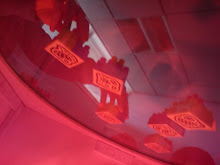Like the ReacTable this instruement looks cool and futuistic and more importamtly makes music in a real time video stream.
It lookes different to the reactable in appearence and sound, the reactable is round and the reatcagon is recangle, the tangiable blocks are all one shape and do different things, the animation is different too.
Ill go into a little detain on how it works.
"The ReacTagon is based on a harmonic table"
The table reminds me of bee hive in the way that it shows a grid of hexigon shaped blocks upon the table top. These hexigon shapes are known as cells acts and they like the keys on the piano, every cell has a fixed note like C for example.
Round coster shaped objects are placed down on the table to create musical sequences. These objects are marked with instructions
 The above object shows the direction of sequence flow and it also deturmins the first note. The note in which the sequence will start will depend on which cell the marker is placed.
The above object shows the direction of sequence flow and it also deturmins the first note. The note in which the sequence will start will depend on which cell the marker is placed.
This marker is known as a ricochet marker, it plays a note when the playhead reaches it. They can be also be used to change the direction of play in real time. Like its name suggests it is used to pass the play to another marker, like another rocochet marker, creating a musical sequence.

The bar consisting of different square blocks located at the bottom of the table is known as the "transposer bar" and it allows the pitch of the musical sequence to be changed.

Another counter known as a "splitter" can be used to dispurce the playhead in several directions
A "stop" counter can be used to stop the play head after the final not it played. Conbine all these markers you can create interesting intricate musical sequences.

Volume, timbre and rythm can be controled by by lower faders located on the side of the reacTogon. By moving up and down the faders with a simple finger depth and colour can be added to the composition.

The faders above these act like sound banks and additional sounds like drum sequencers and other instruments making the composition experience larger and more exhilerating.

No comments:
Post a Comment